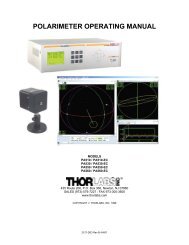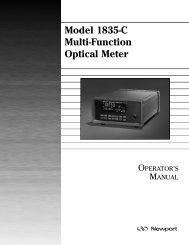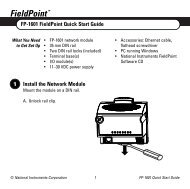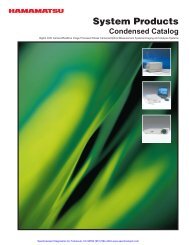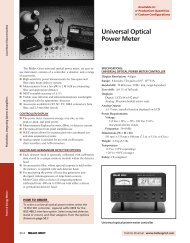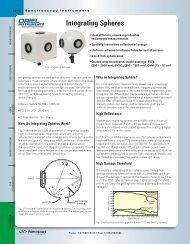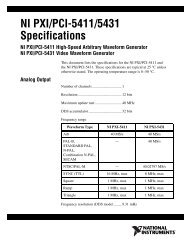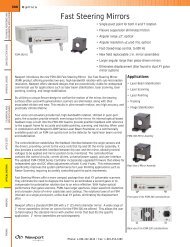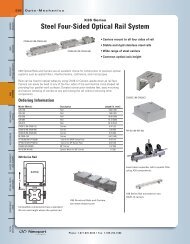(8.5x11) 6000 Manual Cover - Newport Corporation
(8.5x11) 6000 Manual Cover - Newport Corporation
(8.5x11) 6000 Manual Cover - Newport Corporation
Create successful ePaper yourself
Turn your PDF publications into a flip-book with our unique Google optimized e-Paper software.
When the DIG display annunciator is lit, measurements pass through a<br />
moving 10-sample averaging buffer before being further processed, stored or<br />
communicated to the display or computer interfaces. With DIG on, all observable<br />
values represent digitally averaged results relative to the original A/D<br />
conversions. This averaging is independent of the subsequent processing<br />
available through the STATS buffer, Section 2.3.15.<br />
2.3.5 ZERO, Offset Subtraction<br />
This key turns offset subtraction on and off. When turned on, the ZERO<br />
annunciator lights and the last signal reading is saved as S d<br />
and subtracted<br />
from all subsequent signal readings S. This causes subsequent signal calculations<br />
(and the display) to use the value S-S d<br />
instead of S.<br />
Offset subtraction allows one to remove the effects of ambient DC signals, by<br />
zeroing the display before making a measurement. Pressing the ZERO key a<br />
second time turns off the ZERO annunciator and stops offset subtraction.<br />
2.3.6 AUTO, Automatic Gain Ranging<br />
The AUTO key toggles automatic signal ranging on and off. When on, the<br />
AUTO annunciator lights and the signal range (amplifier gain) is adjusted to<br />
utilize maximum analog-to-digital converter resolution. When AUTO is turned<br />
off, the AUTO annunciator is turned off and the signal range is left in its<br />
current state.<br />
Signal range can be manually controlled by the , arrow keys. Pressing an<br />
, arrow key when AUTO is on (and STATS, MENU and λ are off), turns<br />
AUTO off and executes the manual range change. See RANGE, Section 2.3.11.<br />
Signal range changes will often not coincide with observable changes to the<br />
display value as the display is scaled by the detector responsivity and so must<br />
adjust independently. Signal range gains will occur in 1 decade steps when auto<br />
or manual ranging.<br />
AUTO gain ranging is not allowed in SNGL measurement modes. When exiting<br />
a SNGL measurement MODE, AUTO will turn back on if it was on when the<br />
SNGL measurement mode was entered. (See MODE, Section 2.3.13)<br />
2.3.7 CH A (B), Display Channel A (or B)<br />
The 2832-C has a primary channel and secondary channel display area. The<br />
primary channel is displayed in larger, bold characters, with the secondary<br />
channel displayed underneath it in slightly smaller characters.<br />
Depressing the CH A key causes channel A to be the primary display channel.<br />
The CH B key causes channel B to be the primary display channel. The<br />
display channel annunciators will indicate which channel is currently the<br />
primary display channel. When a display channel is selected, the front panel<br />
will change to reflect its settings and measurement data. Operations from the<br />
keypad or menu that affect a specific channel will only affect the currently<br />
displayed primary channel and not the other.<br />
2.3.8 STO REF, Store Reference Value<br />
STO REF causes the last measurement, D, to be stored as D ref<br />
for subsequent<br />
use in relative measurement calculations. When units are relative, REL, and<br />
the stored reference is selected, the displayed value is the ratio D/D ref<br />
. When<br />
units are logarithmic relative, dB, and the stored reference is selected the<br />
8



